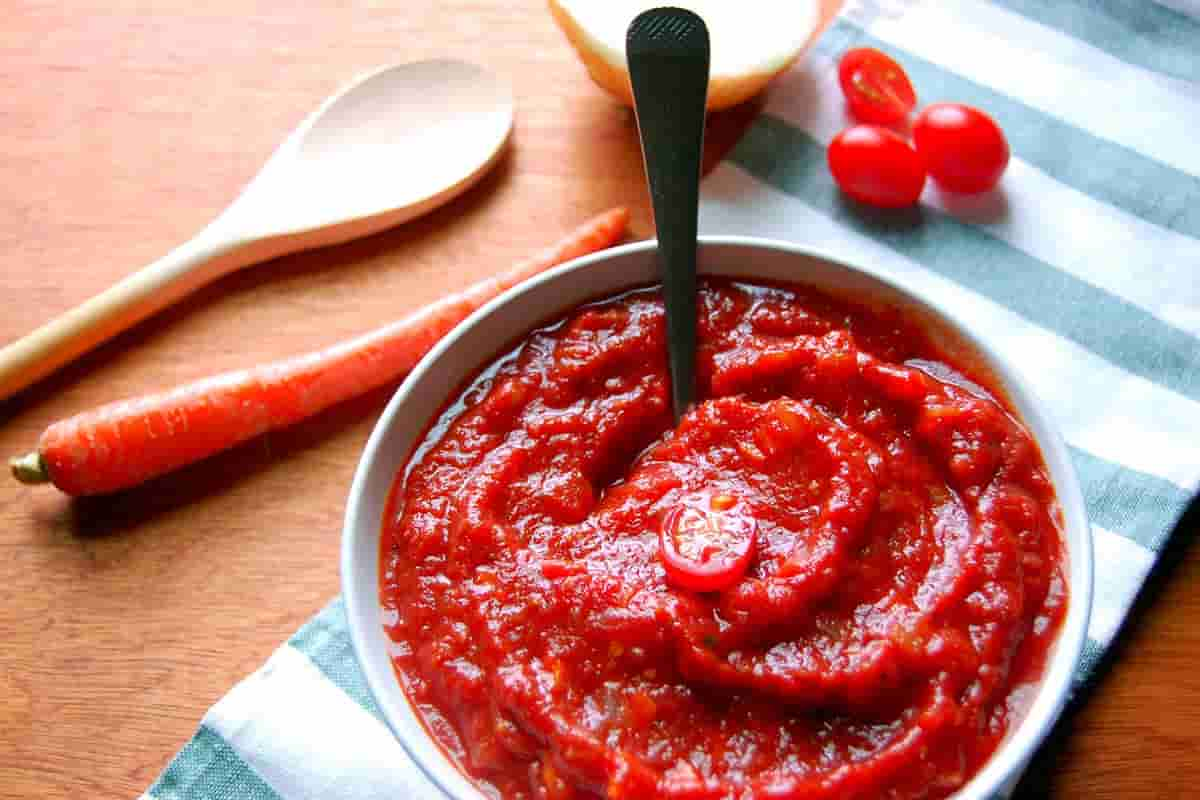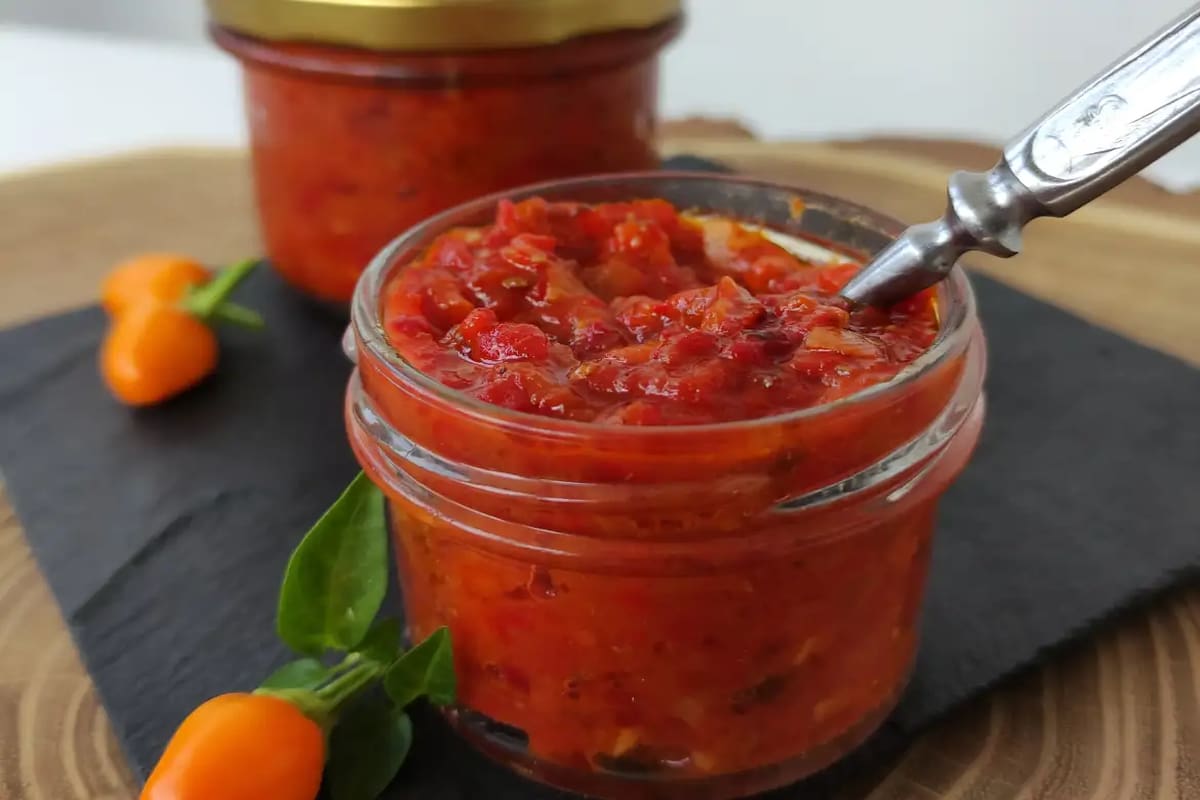Tomato paste or other tomato-based products are different from each other based on various factors. Subsequently, we are going to provide you with beneficial information on the mentioned products’ specifications that you didn’t know before.
Cooking tomatoes over an extended period of time results in the production of a thick paste known as tomato concentrate.
The many hours of simmering aid to lower the water content which is then followed by filtering all of the seeds and skins, then heating the liquid again to reduce the base to a thick, rich concentrate. This concentrated liquid is a vivid crimson color and has a viscous consistency.
Tomato concentrates can be used to rapidly impart a burst of tangy flavors or they can be used to slowly deepen the flavor over time in dishes that are slow-cooked.
Tomato puree and tomato paste are the fundamental components of a large number of different dishes. Tomato sauce and tomato paste can both be derived from tomato puree, which is just the processed pulp of tomatoes.
Tomato puree is different from canned tomatoes and tomato sauce in that it has been carefully pulped and the seeds have been removed. Canned tomatoes and tomato sauce may also have more chunks. Tomato Paste is simply the same puree that has been reduced and boiled down to an essential consistency. We examine the differences between tomato puree and paste, as well as how each is made, in great detail.

What is the difference between tomato paste and tomato puree?
Tomato paste starts off as tomato puree, which is produced from fresh tomatoes. From there, it transforms into tomato paste. When it comes to producing tomato paste, some varieties of tomatoes work far better than others. Because of their small size and high pulp-to-seeds-to-flesh ratio, Roma tomatoes are an excellent choice for this procedure.
On the other hand, you can utilize virtually any variety of tomato. While some tomatoes are more acidic than others and will produce a product with a stronger flavor, some are less acidic and will produce a more subtle flavor. Choose yellow tomatoes for a sweet and soft sauce if you want the flavor to be as subtle as possible.
The next thing you need to do is transfer the puree to an enamel cooking pot, such as one that is designed for boiling spaghetti or for canning in a water bath. Because tomatoes include acid, it is not a good idea to cook them in aluminum or even iron or stainless steel because the fruit can cause the metal to pit. This is because the acid in tomatoes can cause the pitting of the metal.
Sometimes the metal will leak into the cooking sauce, which can add minerals that aren’t desired. You also have the option of preparing the sauce in a slow cooker, sometimes known as a crockpot.
How to Make Tomato Sauce More Thick and Bold
While the pulp is being cooked, the water will be driven out of it, and it will gradually become a paste as it does so. The longer you let it cook, the more it will reduce and become thick. The tomatoes need to be reduced in volume until they become thicker, but this must be done in a way that prevents them from burning.

Because of this, when you see a traditional Italian mother wearing an apron, you will notice that she is constantly stirring the sauce that is simmering in the cooking pot.
Cooking the mixture over a low heat while stirring it frequently and making sure to scrape the sauce from the bottom of the pot is the key to success in this endeavor. Even when using a slow cooker, the sauce will need to be stirred on sometimes, particularly in the later stages of the thickening process. This is very important.
In order to speed up the drying process, some individuals put the tomato paste into shallow pans and place them in the oven. If you use the stovetop or slow cooker approach, you might not obtain the same level of caramelization that you receive from this step. You may even begin the cooking process on the stovetop or in the slow cooker, and then switch to using dehydrator pans for the latter stages of the process.
The Process of Converting Tomato Paste into Tomato Sauce
The technique of making tomato paste involves essentially dehydrating the tomatoes. When put directly to the pizza crust and used as the foundational layer for pizza, tomato paste works extremely well. To make it more like sauce again, add water or tomato juice to it at a ratio of one can of tomato paste to three cans of water. For example, use one can of tomato paste to make three cans of tomato sauce. To taste, or as directed in the recipe, spice. For a heartier sauce, consider including meat, mushrooms, or other veggies.
Find a replacement for tomato paste and tomato sauce here.

The reason you need to find a replacement for tomato sauce or tomato paste is the primary factor that should guide your search for a suitable alternative. There are many options available to you in the event that the problem is simply that you do not now possess the required component.
You could, for instance, make a pizza with catsup as the base, despite the fact that it has an unusual flavor. Alternately, you may use about a spoonful of regular spaghetti sauce, the kind that comes in a jar.
You will get a much better flavor and texture from tomato paste than either of these two stop-gap ingredients, but if you have a hungry family to feed and no time or money to go to the store, you can turn out a product that is credibly a pizza.
Tomato paste will give you a much better flavor and texture. You might alternatively use fresh tomatoes, crushed canned tomatoes, or canned tomatoes in their whole form. Some varieties of canned tomatoes, such as the Mexican blend, provide for a taste transformation that is really quite pleasant.
If a member of your family is allergic to tomatoes, you face a different kind of difficulty than those who do not have this problem. Along with eggplant and peppers, tomatoes are a member of the nightshade family of vegetables. There are some people who are unable to consume tomatoes of any kind, and others who are unable to consume them at all.
Try using yellow tomatoes if you have difficulties with acid reflux or a stomach that hurts from being too acidic after eating tomato products. Despite the fact that they won’t keep as well as red tomatoes, the moderate flavor and low acid level of yellow tomatoes can make a world of difference for tomato lovers who have sensitive stomachs.

Try using pureed pumpkin or squash, or even applesauce or peanut butter as the foundation of a pizza in place of tomato sauce when catering to folks who have a genuine allergy to tomatoes. You can try buttered noodles (you can use margarine instead of butter), Alfredo sauce, or even a brown beef gravy with spaghetti or other similar noodles. There is also the option of using butternut squash or pumpkin soup as an alternate sauce.
Tomatillos provide a different kind of substitute, one that is mostly about the flavor. Tomatillos can be used in place of tomatoes. Since they are also a nightshade, it is unlikely that they will alleviate allergy symptoms. The essential component of green salsa is ripe tomatillos; the unripe, green varieties should not be used.
The pizza sauce can be made from the salsa, or it can be used as a dipping sauce instead.
In some of the recipes, you might also use peanut butter, umeboshi paste, tamarind concentrate, molasses, or even molasses. The question that you need to ask yourself is, “What function does the tomato provide in this recipe?”
Does it function more like a fruit, a vegetable, an adhesive, or an accent?” You won’t always be able to successfully come up with a substitute for the tomato in a recipe, but in many circumstances, you can design a tasty alternative. [Case in point:]




